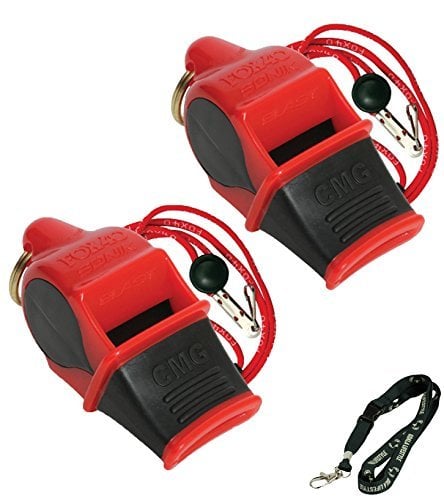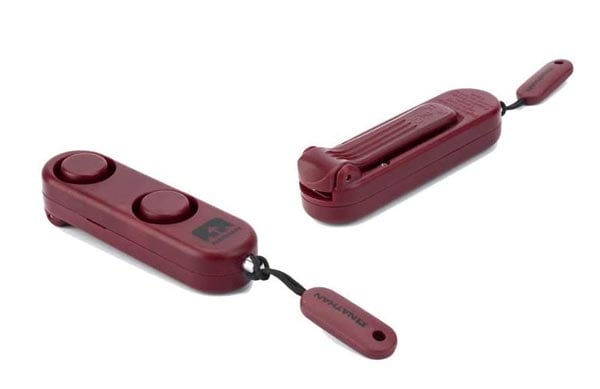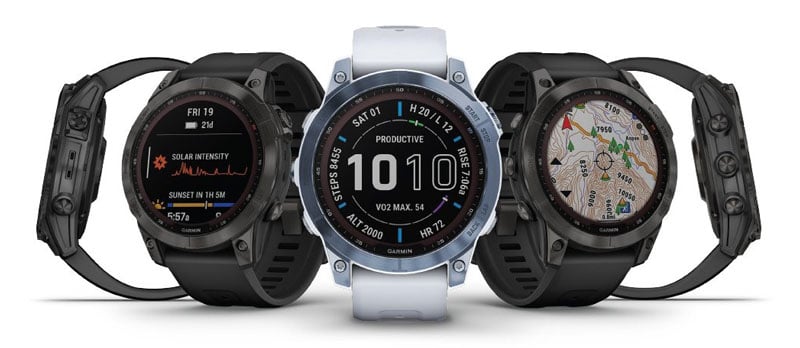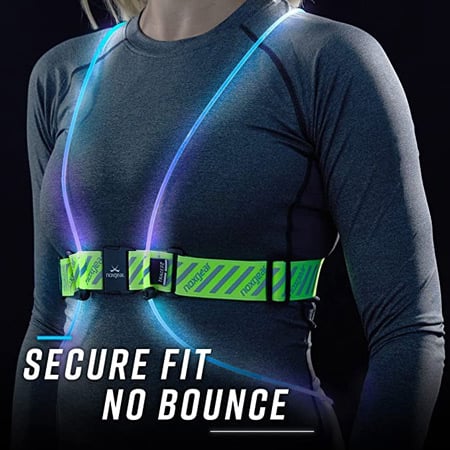If you’re planning to go for a long trail run in a questionably remote area, considering night running solo, or simply ensuring preparation of your personal safety from other people or wildlife encounters – this running safety gear guide is for you!
Some of this gear could literally save your life, in the case of a real emergency. Other emergency scenarios could include:
- Another trail user has an accident and needs some basic first aid
- You find yourself in a situation where you need to protect yourself from a human or animal encounter.
- You’re stuck/lost on a remote trail in bad weather conditions and need to find help.
Some of these survival items are also intended to help you navigate and find your way in case you get lost or injured when trail running and need to find your way back or off the trail and back to a road/town as quickly as possible.
How do you decide what to include and carry with you in your trail running survival kit?
Your running safety gear will vary depending on how remote the trails are, how far you intend to go, whether you’re familiar with the area, and whether you’ll be running alone.
Your tolerance for risk-taking is also a factor in what safety gear you’ll take with you.
If you are planning to run an ultramarathon race then that race may also specify what mandatory running gear and first aid supplies you must carry with you during the race or at least certain stages of it.
This is why it’s worth buying what you know you are going to need, and carrying it with you on some of your ultra runs, to get used to the added weight in your running hydration pack.
💪🏼 If you’re looking for inspiration from other runners, join our Strava Run Club to see what other humans achieve out there on the trails and roads – we love you guys and your run achievements! 🏆
If you’re planning longer trail running and lightweight hiking adventures, for example going fastpacking or going on a multi-day running adventure and plan to stay out overnight, then you may also find our fastpacking gear guide worth a read as it will help you choose the best gear for that.
Running Safety Gear – Table of Contents
I have grouped our recommended running safety gear post into 5 main categories – click the links below to head to the relevant sections, or scroll down to read the full article so you don’t miss any useful information:
- DRAWING ATTENTION – in the event of any emergency
- PROTECTION – Ensuring you have protection from the elements
- HYDRATION – Staying hydrated and reducing nutrition and electrolyte deficiencies
- NAVIGATION – Reducing your chances of getting lost
- OTHER RUNNING SURVIVAL KIT – other gear to consider taking
Drawing Attention to Yourself in a Running Emergency
I like to run without drawing attention to myself unless of course I’m running at night and need to be seen by road users or cyclists for safety reasons.
In which case I’m going to be wearing my headlamp, and reflective running gear.
However, you can bet your bottom dollar that I want everyone to know my exact location if I’m lost, injured or feel endangered!
Here are the 4 best ways to get in contact with someone, if you need to draw attention to yourself when trail running or hiking:
1. Carry a mobile phone when running
While not reliable in remote areas with limited or no signal, it would be a mistake not to carry a phone with you on your long runs.
A phone can be used to track your location and you can obviously use it to work out where you are if you have a signal and do not have a map or GPS watch with navigation features to help you out.
I’ll share my favorite GPS Running watch later in this post but you can also read my roundup of the Best GPS Watches For Running next to learn more about them.
As I’m prone to letting my sleek iPhone slip out of my grip (and pockets), I use a protective case to keep it protected on the trails. Otterbox do some great slimline, highly protective cases – It’s the brand we use.
2. A satellite messenger / Personal Locator Beacon
A satellite messenger with PLB (personal locator beacon) such as the popular Garmin inReach Mini 2, pictured, below, is one of those lifesaving items of gear to carry with you when running in more remote locations where cell signal may not be available.
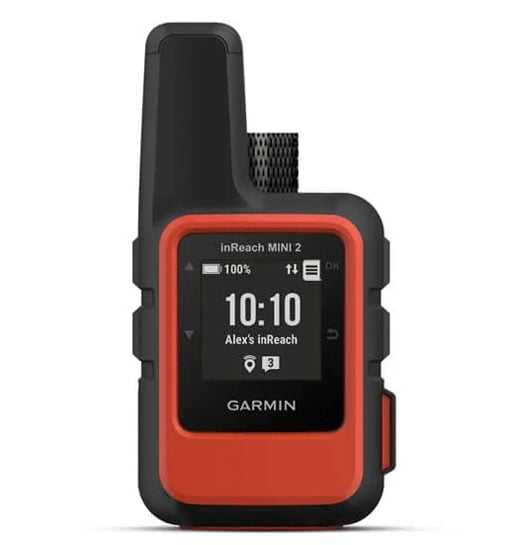
They will have a longer battery life than your smartphone and have the option to contact emergency services via satellite when cell service is limited.
You can also send out messages to your emergency contacts with them should you ever need to.
They are lightweight, highly weather resistant, and can operate at much lower temperatures than regular smartphones too which makes them very useful in colder climates/conditions.
3. Emergency whistle
I don’t mean a feeble little micro-whistle or just the one that comes with your race vest (although that’s better than no whistle).
Invest a little bit more and get a super-loud and reliable whistle which will do the job in an emergency.
We have these Fox 40 whistles, which are handy for scaring off larger carnivores that may show too much of an interest in me, like the local coyotes who sometimes find me a bit too interesting.
You can also use a whistle to draw attention to yourself and anyone near you if you attract unwanted attention or if you’re injured and need assistance.
4. Personal Alarm for Runners and Hikers
Another great option, particularly for female runners concerned about their running safety from unsavory characters is the Ripcord Siren Personal Alarm from Nathan Sports.
It’s worth having a whistle too, however, as if you do any major trail running races (at least, in Europe), they require you to carry one in your emergency kit.
This personal safety alarm is designed specifically for women out running and adventuring alone and weighs hardly anything so it can conveniently be attached to a running vest.
The advantage of the ripcord siren over a loud whistle is that it doesn’t require you to get a whistle to your mouth to blow.
You can attach it to your clothing or race vest and the alarm is triggered by pulling a ripcord, so it’s easy to grasp in an emergency, especially if you’re out of breath.
On the other hand, a ripcord attached to a running vest should be easy to grab quickly in an emergency – and at less than $20 it’s a good investment!
RELATED READING: Is Trail Running Dangerous? How To Stay Safe on the Trails
Protection from the elements when running
1. Lightweight waterproof jacket
Especially if you’re in the mountains or somewhere with changeable weather, make sure you have the right clothing and are prepared for a change in temperature and precipitation with a good quality waterproof running jacket.
Imagine if you hurt yourself and have to wait for help or hobble slowly back to civilization.
A waterproof running jacket could really help reduce your exposure to cold and wet weather, and also sunburn if that’s a risk.
If you need rain protection, make sure you have a fully waterproof jacket, not a windproof or water-resistant jacket.
2. Emergency foil blanket for running
If you’ve run many long trail races then you probably already own one of these useful things.
Emergency foil blankets weigh next to nothing and are mandatory for many trail races.
A heat-reflecting foil blanket can be invaluable as a means of keeping warm if you find yourself stuck out longer than planned. For example, if you’re injured and can’t move (or move fast).
It’s also light-reflective so makes it easier for emergency services to spot you if they’re out searching and you have the blanket out.
3. Buff headgear/neck gaiter
A Buff is a scarf, hat, and tourniquet! Anything you want it to be – a pandemic-era face mask, perhaps?
You can also use a Buff as a water filter to filter out bigger particles and dirt before purifying your water to drink.
Again, a Buff doesn’t weigh very much but it’s very useful as clothing or in an emergency situation.
4. Running cap or warm sweat-wicking hat
A technical running cap or hat (even just a trucker cap) will help keep your head warm while also protecting you from the elements.
I can’t run in sunny weather without a running cap, as I get a sun-burned head, plus sweat gets in my eyes.
For running in cold weather, opt for a winter running hat or headband that will provide good insulation while still being breathable and wicking moisture (including sweat) away from your head, to help keep you warm.
Although not technically running hats, we have designed some exclusive Trail & Kale caps in our online store if you prefer trucker caps – visit via the link below :-).
Staying hydrated when running
1. Water in a soft bottle that doesn’t slosh around when you run
Nobody wants to run out of water on the trails or road for that matter!
Suffering from dehydration is one of the most popular risks facing most runners when they go trail running.
It’s so easy to run out of water and find yourself a few hours from a clean water source.
So I carry one or two soft-flask water bottles with me, with at least one full when I start.
Most hydration packs for running also come with at least 1 soft flask when you buy one.
Soft flasks are great because they are pretty light, don’t slosh around, and fold down small when empty.
2. Water purification tablets
It’s worth carrying a Lifestraw personal water filter with you if you plan on going for a very long training run in wild places, maybe because you’re training for a marathon or ultramarathon, for example.
A filter straw like this will give you the much-needed ability to create safe drinking water even from the most questionable water sources.
For more information on filtering and purifying your water in the backcountry, read our guide to creating safe drinking water while backpacking, you never know when this information may come in handy!
3. Salt capsules or tablets
Especially when running somewhere hot, salt capsules are great to take to prevent issues such as cramping when running or hiking.
Here’s some advice on how to prevent muscle cramps while running, should you need to!
4. Emergency food to take trail running
It’s miserable to run out of energy when all you need is a little snack and you’ll feel much perkier.
I take a variety of food and snacks as well as energy gels & chews on my long runs, depending on what I think I’ll feel like consuming.
Navigation when running to avoid getting lost
1. Map and compass
Especially if you’re trail running somewhere new, remote and / or with difficult terrain, having a map of the area with key landmarks, including peaks, rivers, ranger stations and roads marked will help you avoid getting lost (or find your way if you go off-track).
We like the National Geographic Trails Illustrated maps and Silva compasses like this one.
2. A GPS running watch
While not a substitute for a map, having a GPS running watch that tracks your location, altitude, and position in relation to where you started, can be an invaluable asset for helping you find your way.
Great watches like the Garmin Fenix 7 series also include features that help you retrace your steps back to the start of your run, or follow a pre-planned route that you can upload to the watch before heading out on your trail run.
Head over to our Best GPS Running Watches buyer’s guide next to learn more about the ‘best of the best’ GPS watches for running.
The Garmin Fenix 7 series as well as my current Forerunner 965 watch both also have an awesome feature called LiveTrack.
When activated, this feature sends an email to contacts of your choice when you start a run.
That chosen person/people can then live-track your location as you run, up until you finish, or for an extra period of time afterward, if you set it up that way.
Helen and I both use this for all our runs as we don’t always run together due to our difference in speed and routes.
If you’re interested to know how to run with your partner who runs at a different pace to you, check out these 4 Ways To Run With Someone Slower Than You (Or Faster Than You).
Other Runners Emergency Kit / Survival Gear
1. Small trail running first aid kit
I don’t go around carrying a bag of first aid kit on my trail runs, which would be useful but a bit excessive.
But I do take a small waterproof pouch containing a gauze pad, tape, a pin, a disinfectant wipe, and a couple of plasters.
This small running first aid kit enables me to patch up minor issues such as blisters or a minor cut, and I carry the Buff headgear mentioned above, which can be used as a tourniquet or bandage in case of an emergency.
2. Small lightweight emergency headlamp for night running
If I’m not planning to run in the dark then I won’t carry my running headlamp, unless of course, I feel like the sun may set during my run.
A running safety light, like a headlamp, can be useful for so many reasons when night running, they’re also very affordable for the amount of use they get. A headlamp makes for the perfect gift for the trail runner in your life because of this.
Read my guide to running at night next for more night running gear recommendations, tips, and advice.
But I stash this perfect little HeadLamp 325 in my running vest, just in case I get stuck out in low light or darkness falls (it happens!).
It’s also worth considering buying a reflective running vest (sometimes referred to as a running safety vest)as it can be hard to stay visible even in the evening when dusk is approaching, which happens at its fastest in the winter months.
Safety lights for running are also a good option to take with you at night, like for example the Noxgear Tracer360 Illuminated reflective vest which is illumated as well as being reflective.
RELATED READING: Best Running Headlamps for Trail Running & Ultrarunning
3. Pepper spray for runners and hikers
Depending on where you are going, and assuming it’s legal in your country, it may be worth taking a small can of pepper spray as a defense weapon for women against the unlikely but potential risk of encountering an unsavoury character.
Pepper spray for runners is also very useful when encountering an aggressive wild animal that isn’t put off by your use of the super-loud whistle or personal alarm.
See this running weapon as the last line of defense in situations invoving wild animals.
For the spray to be useful, it needs to be stored somewhere you can get it out and open quickly and easily.
You can also get bigger cans of bear spray, which travels further when sprayed, but a small can of pepper spray is what I would be more likely to take with me if I felt a need for it.
Running Safety Gear Summary
While nobody expects emergency situations to occur when going out for a run, they can happen and it is good for your own safety and that of others if you can be prepared with some simple running safety gear.
Fail to prepare; prepare to fail.
I hope this list has helped you consider what you may want to take with you on your next long run out on the trails or night run.
If you have any comments or questions about running safety, or what emergency survival gear to take with you, drop us a comment below.


